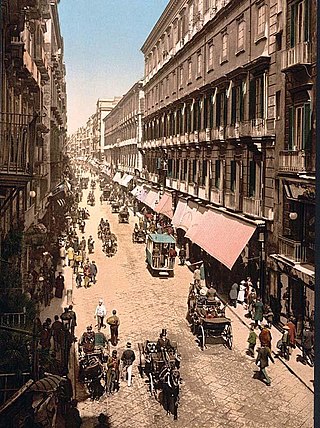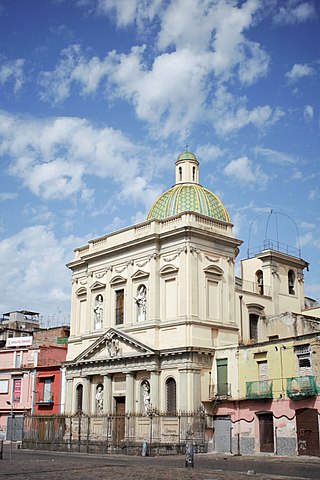
Naples is the regional capital of Campania and the third-largest city of Italy, after Rome and Milan, with a population of 909,048 within the city's administrative limits as of 2022. Its province-level municipality is the third-most populous metropolitan city in Italy with a population of 3,115,320 residents, and its metropolitan area stretches beyond the boundaries of the city wall for approximately 30 kilometres.

Masaniello was an Italian fisherman who became leader of the 1647 revolt against the rule of Habsburg Spain in the Kingdom of Naples.

Caserta is the capital of the province of Caserta in the Campania region of Italy. An important agricultural, commercial, and industrial comune and city, Caserta is located 36 kilometers north of Naples on the edge of the Campanian plain at the foot of the Campanian Subapennine mountain range. The city is best known for the 18th-century Bourbon Royal Palace of Caserta.
The Neapolitan Republic was a republic created in the Kingdom of Naples, which lasted from October 22, 1647, to April 5, 1648. It began after the successful revolt led by Masaniello and Giulio Genoino against King Philip III and his viceroys.

Cosimo Fanzago was an Italian architect and sculptor, generally considered the greatest such artist of the Baroque period in Naples, Italy.

Vomero is a bustling hilltop district of metropolitan Naples, Italy — comprising approximately two square kilometres (0.77 sq mi) and a population of 48,000.

Santa Maria del Carmine is a church in Naples, Italy. It is at one end of Piazza Mercato, the centre of civic life in Naples for many centuries until it was cut off from the rest of the city by urban renewal in 1900. The church was founded in the 13th century by Carmelite friars driven from the Holy Land in the Crusades, presumably arriving in the Bay of Naples aboard Amalfitan ships. Some sources, however, place the original refugees from Mount Carmel as early as the eighth century. The church is still in use and the 75–metre bell tower is visible from a distance even amidst taller modern buildings.

Arenella is a quarter of Naples, southern Italy. It is on the Vomero hill above the city and was, 300 meters in elevation. Many years ago was considered a place to go to "get away from it all". It is near to the main hospital section of the city, set somewhat higher, on the way up to the Hermitage of Camaldoli. It has some points of historic interest, such as the presence of the workshop of Giambattista della Porta.

Piazza Dante is a large public square in Naples, Italy, named after the poet Dante Alighieri. The square is dominated by a 19th-century statue of the poet Dante, sculpted by Tito Angelini.

Piazza della Repubblica is a city square in Florence, Italy. It was originally the site of the city's forum; then of its old ghetto, which was swept away during the improvement works, or Risanamento, initiated during the brief period when Florence was the capital of a reunited Italy—work that also created the city's avenues and boulevards. At that time, the Loggia del Pesce from the Mercato Vecchio was also moved to Piazza Ciompi. The square's Giubbe Rosse cafe has long been a meeting place for famous artists and writers, notably those of Futurism.

The Four Days of Naples was an uprising in Naples, Italy, against Nazi German occupation forces from September 27 to September 30, 1943, immediately prior to the arrival of Allied forces in Naples on October 1 during World War II.

Via Toledo is an ancient street and one of the most important shopping thoroughfares in the city of Naples, Italy. The street is almost 1.2 kilometres (0.75 mi) long and starts at Piazza Dante and ends in Piazza Trieste e Trento, near Piazza del Plebiscito.

Santa Croce e Purgatorio al Mercato is a church in the center of the Piazza Mercato, in Naples, Italy.

The Bourbon Tunnel, Tunnel Borbonico or Bourbon Gallery is an ancient underground passage, constructed for military purposes to connect the Royal Palace to military barracks in Naples, Italy.

San Giovanni a Mare is a church in Naples, Italy; located near the docks, not far from the church of Sant'Eligio Maggiore.

The Fountain of Neptune is a monumental fountain, located in Municipio square, in Naples, Italy. The fountain until the end of 2014 was located across the street of via Medina across from the church of Santa Maria Incoronata, Naples and a few doors south of the church complex of Pieta di Turchini. Now the fountain is located in front of the Town hill building, its location changed due to the construction of the new underground station.

The Catacombs of Saint Gaudiosus are underground paleo-Christian burial sites, located in the northern area of the city of Naples.

The Porta Nolana is the remnant of one of the medieval city gates in Naples, Italy. It is located in Piazza Nolana, near a local train station, Napoli Porta Nolana with the Circumvesuviana lines, and a bustling local pedestrian market, Mercato di Porta Nolano, known for seafood. It takes its name from the road that lead to Nola.

The Caffè Gambrinus is a historic, private cafe or coffeehouse in Central Naples, Italy on via Chiaia. It is located in the rear of the Palazzo della Prefettura, which lies in front and to side of the Royal Palace of Naples, both of which face the Piazza del Plebiscito. The name Gambrinus is a legendary somewhat tipsy figure of joviality, and his name is used for various brands and many establishments.

Piazza delle Erbe is one of the many squares in the historic center of Padua. For centuries, with Piazza della Frutta, it was the commercial center of the city. In the two squares is one of the largest markets in Italy. Unlike Piazza dei Signori, the civic theater of celebrations, Piazza delle Erbe was the site of the folk festivities. The square is dominated by the imposing Palazzo della Ragione.



















